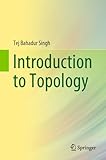Introduction to topology
Material type: TextPublication details: Springer 2019 SingaporeDescription: xix, 452 p. Includes bibliographical references and indexISBN:
TextPublication details: Springer 2019 SingaporeDescription: xix, 452 p. Includes bibliographical references and indexISBN: - 9789811369537
- 514 S4I6
| Item type | Current library | Collection | Call number | Status | Date due | Barcode | Item holds | |
|---|---|---|---|---|---|---|---|---|
 Book
Book
|
Ahmedabad General Stacks | Non-fiction | 514 S4I6 (Browse shelf(Opens below)) | Added to bundle | 201404 |
Browsing Ahmedabad shelves, Shelving location: General Stacks, Collection: Non-fiction Close shelf browser (Hides shelf browser)

|

|

|

|

|

|

|
||
| 514 E2C6 Computational topology: an introduction | 514 E2T6 Topology: a very short introduction | 514 G4E5 Elementary applied topology | 514 S4I6 Introduction to topology | 514 Z6T6 Topology for computing | 514.23 K2C6 Computational homology | 514.32 S2P7 Probabilistic metric spaces |
Table of contents
1.Topological Spaces
1.1.Metric Spaces
1.2.Topologies
1.3.Derived Concepts
1.4.Bases
1.5.Subspaces
2.Continuity and the Product Topology
2.1.Continuous Functions
2.2.Product Spaces
3.Connectedness
3.1.Connected Spaces
3.2.Connected Components
3.3.Path-connected Spaces
3.4.Local Connectivity
4.Convergence
4.1.Sequences
4.2.Nets
4.3.Filters
4.4.Hausdorff Spaces
5.Compactness
5.1.Compact Spaces
5.2.Countably Compact Spaces
5.3.Compact Metric Spaces
5.4.Locally Compact Spaces
5.5.Proper Maps
6.Topological Constructions
6.1.Quotient Spaces
6.2.Identification Maps
6.3.Cones, Suspensions, and Joins
6.4.Topological Sums
6.5.Adjunction Spaces
6.6.Induced and Coinduced Topologies
7.Countability Axioms
7.1.First and Second Countable Spaces
7.2.Separable and Lindelof Spaces
8.Separation Axioms
8.1.Regular Spaces
8.2.Normal Spaces
Contents note continued: 8.3.Completely Regular Spaces
9.Paracompactness and Metrizability
9.1.Paracompact Spaces
9.2.A Metrization Theorem
10.Completeness
10.1.Complete Spaces
10.2.Completion
10.3.Baire Spaces
11.Function Spaces
11.1.Topology of Pointwise Convergence
11.2.Compact-Open Topology
11.3.Topology of Compact Convergence
12.Topological Groups
12.1.Basic Properties
12.2.Subgroups
12.3.Quotient Groups and Isomorphisms
12.4.Direct Products
13.Transformation Groups
13.1.Group Actions
13.2.Geometric Motions
14.The Fundamental Group
14.1.Homotopic Maps
14.2.The Fundamental Group
14.3.Fundamental Groups of Spheres
14.4.Some Group Theory
14.5.The Seifert-van Kampen Theorem
15.Covering Spaces
15.1.Covering Maps
15.2.The Lifting Problem
15.3.Action of π(X, x0) on the Fiber p-1(x0)
15.4.Equivalence of Covering Spaces
15.5.Regular Coverings and A Discrete Group Action
Contents note continued: 15.6.The Existence of Covering Spaces
Topology is a large subject with several branches, broadly categorized as algebraic topology, point-set topology, and geometric topology. Point-set topology is the main language for a broad range of mathematical disciplines, while algebraic topology offers as a powerful tool for studying problems in geometry and numerous other areas of mathematics. This book presents the basic concepts of topology, including virtually all of the traditional topics in point-set topology, as well as elementary topics in algebraic topology such as fundamental groups and covering spaces. It also discusses topological groups and transformation groups. When combined with a working knowledge of analysis and algebra, this book offers a valuable resource for advanced undergraduate and beginning graduate students of mathematics specializing in algebraic topology and harmonic analysis.
https://www.springer.com/gp/book/9789811369537
There are no comments on this title.

